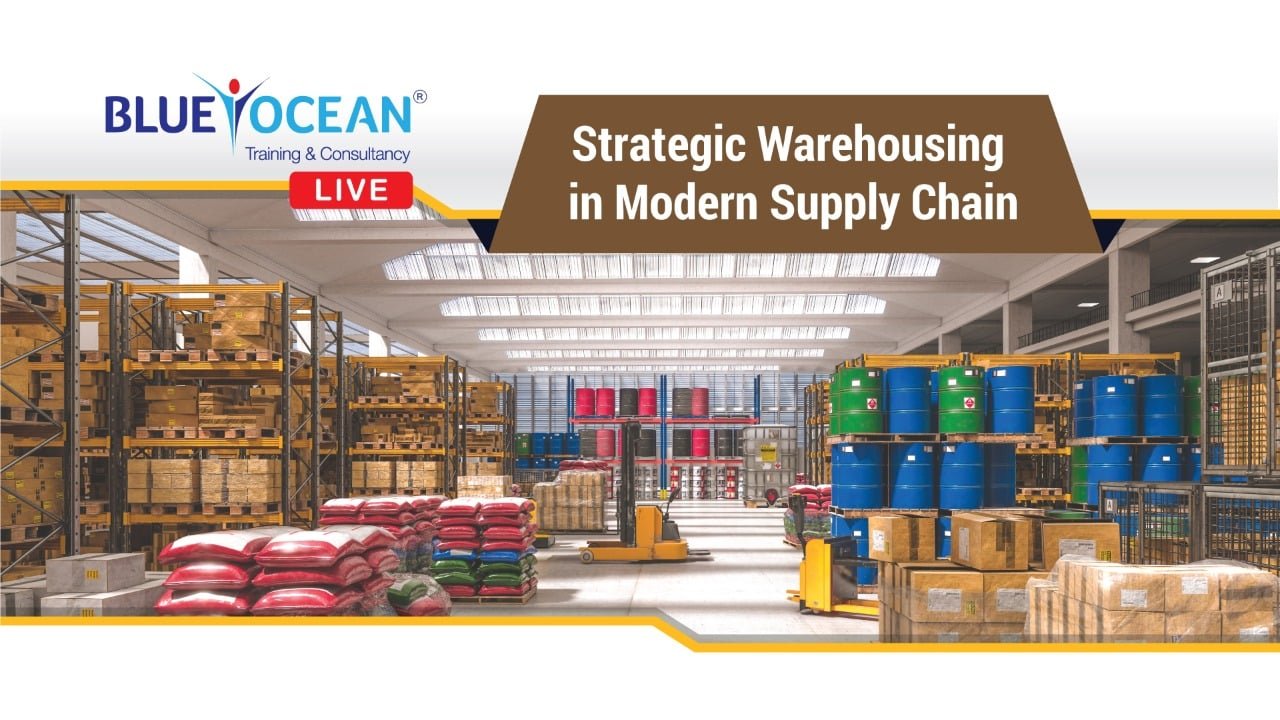Strategic Warehousing in Modern Supply Chain- Free Webinar
 In recent years, especially with e-commerce gaining prominence day by day, traditional warehousing roles have undergone a sea change. They are no longer idle storage places, instead, they play an ‘active’ and ‘strategic’ role in the critical logistics function. The webinar conducted by Blue Ocean Academy on ‘Strategic Warehousing in Modern Supply Chain’ focussed on improving warehouse efficiency to achieve the strategic goals of organizations.
The following are the important points discussed in the webinar:
Traditionally, warehouses were considered as a commercial building used to store goods. The focus was long-term, safe and secure storage. Currently, there is a big change in the way organizations consider warehouses. There was a transition from the idea of passive storage to active distribution with a focus on quick response to customer needs.
In recent years, especially with e-commerce gaining prominence day by day, traditional warehousing roles have undergone a sea change. They are no longer idle storage places, instead, they play an ‘active’ and ‘strategic’ role in the critical logistics function. The webinar conducted by Blue Ocean Academy on ‘Strategic Warehousing in Modern Supply Chain’ focussed on improving warehouse efficiency to achieve the strategic goals of organizations.
The following are the important points discussed in the webinar:
Traditionally, warehouses were considered as a commercial building used to store goods. The focus was long-term, safe and secure storage. Currently, there is a big change in the way organizations consider warehouses. There was a transition from the idea of passive storage to active distribution with a focus on quick response to customer needs.
Strategic warehousing
In modern supply chain management, warehousing plays an important strategic role rather than a ‘passive storage role’. Warehouses are now more focused on distribution and assortment. Strategically located distribution centers are central to modern retailing. The strategic location of warehouses also offers the benefit of consolidated transportation. Warehouses are now equipped to respond to changing customer requirements.
- Distribution centres: A distribution center is a warehouse where the main objective is to redistribute the goods to retailers or end customers.
- Cross-dock facilities- Cross-docking is the practice of unloading materials from incoming transport vehicles and directly loading these into outbound transport vehicles, with little or no storage in between.
- Break-bulk centres- These warehouses receive large shipments from the manufacturing plant and break down these into smaller shipments for multiple customers.
Improving warehouse efficiency
- Improve product flow: A faster flow is achieved if the time to find items is minimized. An effective flow would avoid congestion. Different functions like receiving, storage, picking, packaging and despatch should not interfere with one another. Rack arrangements based on demand, u-shaped layout and fan-shaped layout can improve product flow.
- Improve space utilization: Use of random storage rather than fixed storage, reduction of non-moving inventory and aisle width and usage of mezzanine floors are some solutions.
- Use of modern material handling equipment:
The following are important material handling equipment:
- Narrow aisle or turret trucks – These forklift trucks are designed to work with a narrow aisle or very narrow aisle racking systems
- Sideloaders – These are designed to handle long loads safely.
- AGV stackers – These are driverless automated guided vehicles which can lift pallets into the racking at various heights
- Articulated forklift trucks – These trucks are highly flexible and can be used both inside and outside the warehouse.
Facebook
Twitter
LinkedIn
WhatsApp
Email
Sustainability & Supply Chain Building a Better Tomorrow
In the current scenario, sustainability in supply chains is crucial as businesses strive to reduce their environmental footprint while maintaining…


